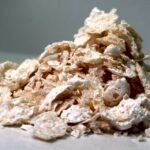Health bakery products are becoming as popular as innovative food. The present study was planned to develop a fortified biscuit with Defatted Soy Flour to increase the protein content. The protein content of the developed biscuits was more than doubled than that of “Control Biscuit”. Calcium, phosphorus, and iron content also increased in the developed biscuits. Such food will boost up the food industry, suggest K. B. Kamaliya and Rema S.
Table of Contents
Changes in the socio-economic conditions have increased the domestic demand and consumption of processed food including bakery products. Health bakery products are becoming as popular as innovative products. The protein-energy malnutrition (PEM) is the major nutritional deficiency disease particularly among children in third world countries including India. Defatted Soy flour (DSF) contains around 50 % protein with a good amino acid pattern. Therefore, many workers suggested using DSF to increase the protein quantity and quality of the food product. Nowadays an Indian-mothers give biscuits to their children as soon as they learn to eat. The protein content of such commercial biscuits is low and can easily be increased by replacing refined wheat flour (RWF) with DSF. Therefore, the present study was planned to develop biscuits using DSF to improve the protein quantity and quality of commercial biscuit and evaluate its effect on the growth of the children.
Materials and Methods
Good quality raw ingredients were procured from the local market of Vallabh Vidhyanagar and Anand except for DSF, which was procured from “Sakthi Sugars Ltd. (Soy Division)”, Coimbatore. Two recipes namely vanilla biscuit and glucose biscuit were selected through a survey of the local market and prepared in the laboratory conditions.
The recipe for control biscuit (CB) was standardized by substituting various sources of fat at different levels and various levels of sugar in the selected formulas and subsequent changes in the quantity of minor ingredients and processing conditions were carried out. After every substitution biscuits were evaluated for sensory characteristics using a 9 point hedonic scale to judge the acceptability. Initially, DSF was replaced to RWF from 5 to 45 % in the CB formula and subsequent changes were made and evaluated using nine-point hedonic scale.
Finally, 25, 30 and 35 % of DSF were replaced to RWF, and biscuits were evaluated for final selection using a composite scoring test prescribed by CFTRI, Mysore (Appendix 3) (8 trained panelists X 3 replications) on the next day and after 4 days of preparation to obtain optimized experimental formula. The biscuit showing the highest score was considered as developed biscuit.
The various nutrients of control and developed biscuits were analysed for various nutrients as per the standard methods.
The production cost of developed products was calculated on the current cost (at the time of experiments) of the raw ingredients in the commercial market and compared with control products. The biscuits were weighed and diameter (D) and thickness (T) were measured and the spread ratio was calculated to know the physical properties of biscuits. The hardness was measured by the three-point break technique of Gaines (1991).

Results
Product Standardization:
The final formula (in baker’s percentage) obtained was RWF 100%, Margarine 25%, Cottonseed oil 25%, Sugar 40%, Liquid glucose 2%, Vanilla essence 0.25%, Salt 1%, Ammonium bicarbonate 0.5% and distilled water 10%.
Product Development:
The DSF was replaced to RWF in the standardized formula from 5 to 45% (with multiple of 5%) and evaluated sensorily. The biscuit prepared by replacing (maximum) up to 30% DSF showed “neither like nor dislike” acceptability compared to CB when judged using a nine-point hedonic rating scale. Therefore, it was decided to prepare biscuit with 25, 30 and 35% DSF replacement level for final selection. The overall acceptability score of biscuit (both days) is presented as graph in Figure-1. The biscuit prepared using 25% replacement of DSF, ranked highest (p d” 0.05) in all the sensory characteristics followed by 30% replacement with only a marginal difference for all sensory characteristics. There was slight decrease in the all most all the sensory characteristics when the biscuits were analysed after four days of preparation.

Physical Properties of Soy Fortified Biscuits:
The physical outlook of biscuit effect on consumer acceptability at first sight therefore, the physical characteristics of the biscuits obtained is represented as table-1. There was a reduction in diameter and an increase in thickness that results in a decrease in spread ratio when DSF was replaced. The weight and hardness were also increased upon the addition of DSF. That may be due to more water retention capacity of DSF.
Nutrient Composition of Soy Fortified Biscuits:
The nutrients content of developed biscuits were compared with a commercial biscuit. The data are shown in table-2. The protein content of developed biscuits was more than doubled (i.e. increased to 127.85%) as compared to CB. The quantity of protein supplied by seven biscuits of 3o % DSF can meet 1/3 rd RDA of preschool children thus the 30% DSF replaced biscuit was selected as the experimental biscuit though the sensory score obtained by 25% DSF replaced biscuit was slightly higher. The fiber level was also doubled in developed biscuits as compared to control. That is an additional benefit to preschool children as it helps in the digestion. Calcium, phosphorus and iron was increased from 4.10 to 66.20, 30.19 to 198.07 and 0.25 to 2.82 mg per 100 gm product, respectively. All these nutrients are essential for children for bone and blood development.

Production Cost of Fortified Biscuits:
The ingredients used for the preparation of different biscuits were similar except for the quantity of RWF and DSF. The cost price of the experimental biscuit was higher by Rs. 4/- than the cost price of the control biscuit because the cost of defatted soy flour is double than refined wheat flour. The cost difference can easily be worked out if DSF is purchased in bulk and secondly by selling the experimental biscuit at a premium because of its therapeutic properties. The ‘threptin’ brand of high protein biscuit containing 30% protein, available commercially costs Rs. 500/kg whereas the experimental biscuit developed in this study costs only Rs. 60/kg although it supplies about ½ the protein supplied by ‘threptin’ biscuit. This indicates the potential market for the developed biscuit keeping in view the benefit of low cost. However, looking to the protein value possessed by developed biscuits, the cost difference can easily meet in terms of saving lots of national fund spending for the proper growth of children and medical treatment, if PEM occurred.
Conclusion
It may be concluded that the Biscuit prepared by replacing 30% Defatted Soy Flour is acceptable and could be promoted as health food. This would also boost-up the bakery industry. Like protein-rich biscuit various health bakery products could be developed that would be win-win situation for both communities as well as food industries.
‘Processed Food Industry’: The Voice of Food Processing Industry
Processed Food Industry (PFI) is a premier English-language monthly B2B publication (ISSN 09721649) headquartered in New Delhi, catering to the vibrant and ever-evolving food processing industry. While we don’t claim to be the largest or most widely read, our proud legacy of over 27 years—publishing continuously since 1997—has earned us the trust of industry professionals as a reliable source of insights and information.
If your goal is to tap into the booming Indian and South Asian markets to promote your equipment, technology, software, or consumables, PFI is your strategic partner. With our hybrid approach across print, web, and social media, we help you establish strong brand recognition rooted in market relevance. Backed by a team of top-tier technical writers, we’re ready to work closely with you and your customers to craft compelling content that drives results.
India and South Asia’s food industry is expanding rapidly, driven by efficiency and cutting-edge innovations. Don’t miss the opportunity to elevate your brand and engage with this dynamic market. Get our 2025 media kit to fine-tune your marketing strategy, increase your visibility, and convert potential customers into valuable conversations. Additionally, ask for a sample copy of our monthly magazine and experience the quality and relevance we deliver.
Let us help you define your role in the future of the food processing industry.

Have a news or topic to share with industry? Write to us editorial@pfionline.com















